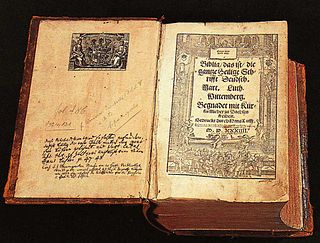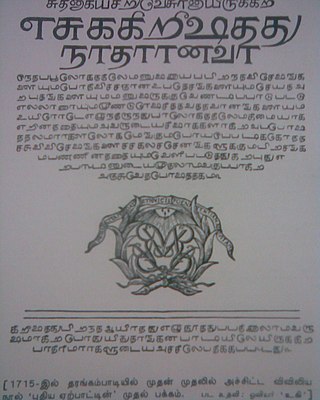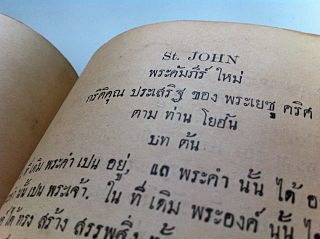Related Research Articles

The New World Translation of the Holy Scriptures (NWT) is a translation of the Bible published by the Watch Tower Bible and Tract Society; it is used and distributed by Jehovah's Witnesses. The New Testament portion was released first, in 1950, as The New World Translation of the Christian Greek Scriptures, with the complete New World Translation of the Bible released in 1961.
Kwanyama or Cuanhama is a national language of Angola and Namibia. It is a standardized dialect of the Ovambo language, and is mutually intelligible with Oshindonga, the other Ovambo dialect with a standard written form.

There are two main translations of the Bible into Japanese widely in use today—the New Interconfessional Version and the New Japanese Bible. The New Japanese Bible, published by the Organization for the New Japanese Bible Translation (新日本聖書刊行会) and distributed by Inochinokotoba-sha, aims to be a literal translation using modern Japanese, while the New Interconfessional Version, published by the Japan Bible Society, aims to be ecumenically used by all Christian denominations and must therefore conform to various theologies. Protestant Evangelicals most often use the New Japanese Bible, but the New Interconfessional Version is the most widely distributed and the one used by the Catholic Church, the United Church of Christ, Lutheran Church factions and many Anglicans in Japan.
Bible translations into French date back to the Medieval era. After a number of French Bible translations in the Middle Ages, the first printed translation of the Bible into French was the work of the French theologian Jacques Lefèvre d'Étaples in 1530 in Antwerp. This was substantially revised and improved in 1535 by Pierre Robert Olivétan. This Bible, in turn, became the basis of the first French Catholic Bible, published at Leuven in 1550, the work of Nicholas de Leuze and François de Larben. Finally, the Bible de Port-Royal, prepared by Antoine Lemaistre and his brother Louis Isaac Lemaistre, finished in 1695, achieved broad acceptance among both Catholics and Protestants. Jean-Frédéric Ostervald's version (1744) also enjoyed widespread popularity.

Sacred Name Bibles are Bible translations that consistently use Hebraic forms of the God of Israel's personal name, instead of its English language translation, in both the Old and New Testaments. Some Bible versions, such as the Jerusalem Bible, employ the name Yahweh, a transliteration of the Hebrew tetragrammaton (YHWH), in the English text of the Old Testament, where traditional English versions have LORD.
The Bible has been translated into Italian many times since the first printed translation, the so-called Malermi Bible, by Nicolò Malermi in 1471. The CEI Bible published by the Episcopal Conference of Italy is the official version of the Italian Catholic Church. Prior to the initial publication of the CEI edition in 1971, the most common Italian translation of the bible was that of Archbishop Antonio Martini, published from 1769 to 1781. The 1607 Italian translation by Giovanni Diodati is the standard reference used in Italian Protestantism; a revised edition of this translation in modern Italian, Nuova Diodati, was published in 1991.

A Protestant Bible is a Christian Bible whose translation or revision was produced by Protestant Christians. Such Bibles comprise 39 books of the Old Testament and 27 books of the New Testament, for a total of 66 books. Some Protestants use Bibles which also include 14 additional books in a section known as the Apocrypha bringing the total to 80 books. This is in contrast with the 73 books of the Catholic Bible, which includes seven deuterocanonical books as a part of the Old Testament. The division between protocanonical and deuterocanonical books is not accepted by all Protestants who simply view books as being canonical or not and therefore classify books found in the Deuterocanon, along with other books, as part of the Apocrypha. Sometimes the term "Protestant Bible" is simply used as a shorthand for a bible which contains only the 66 books of the Old and New Testaments.

The first Bible translations into Hungarian date from the 15-16th centuries, as do the first Hussite Bible and the Vizsoly Bible.
Until the 1990s, most Korean Bible translations used old-fashioned, antiquated language. This made it difficult for Christians that preferred colloquial terms to comprehend what the Bible said. By the 1990s, more colloquial and contemporary versions of the Korean Bible translations came about for Christians, which made it easier for them to comprehend and understand the words from the Bible in a more precise way.

The earliest Bible translations into Polish date to the 13th century. The first full ones were completed in the 16th.

The known history of Bible translation into Ukrainian began in the 16th century with Peresopnytsia Gospels, which included only four Gospels of the New Testament.
Work on translation of the Bible into the Kazakh language began with the work of Charles Fraser of the Scottish Missionary Society. Fraser's translation of Matthew was published in 1818, and the New Testament in 1820 by the Russian Bible Society. J. M. E. Gottwald, a professor at Kazan University, revised it, and this was published in 1880 by the British and Foreign Bible Society in Kazan, and it was republished in 1887, and 1910. George W. Hunter, of the China Inland Mission in Ürümqi, considered this translation to be "a good translation, into Astrahan-Turki", he does not seem to have considered it to be Kazakh. Darlow and Moule say that it was intended for Kyrgyz in the neighbourhood of Orenburg, and the language was sometimes called "Orenburg Tatar". According to Rev. W. Nicholson of the Royal Asiatic Society in St Petersburg this translation was intended for "The Kirghese hordes—Great, Little, and Middle, as they are called—[who] occupy various regions in Southern Siberia, Central Asia, and west of the Caspian Sea." George A. King says Fraser's translation was into the language of the "Western Kirghiz or Kirghiz-Kazak, though they disown the name Kirghiz".
The modern Vietnamese alphabet chữ Quốc ngữ was created by Portuguese and Italian Jesuit missionaries and institutionalized by Alexandre de Rhodes with the first printing of Catholic texts in Vietnamese in 1651, but not the Bible. Some New Testament extracts were translated and printed in catechisms in Thailand in 1872.
Translation of the Bible into Malayalam began in 1806. Church historians say Kayamkulam Philipose Ramban, a scholar from Kayamkulam, translated the Bible from Syriac into Malayalam in 1811 to help the faithful get a better understanding of the scripture. The Manjummal translation is the first Catholic version of the Bible in Malayalam. This is the direct translation from Latin. The four Gospels and the Acts of the Apostles were translated by the inmates of the Manjummal Ashram, Fr. Aloysius, Fr. Michael and Fr. Polycarp. The Pancha Granthy came out from Mannanam under the leadership of Nidhirikkal Mani Kathanar in 1924. The Catholic New Testament was published in full in 1940. and has influenced development of the modern language.

The history of Bible translations into the Tamil language commences with the arrival of Bartholomäus Ziegenbalg at Tranquebar in 1706.Johann Philipp Fabricius, a German, revised Ziegenbalg's and others work to produce the standard Tamil version. Seventy years after Fabricius, at the invitation of Peter Percival a Saiva scholar, Arumuka Navalar, produced a "tentative" translation, which is known as the "Navalar version," and was largely rejected by Tamil Protestants.

Bible translations into the languages of Indonesia and Malaysia have a lot of common history up until the modern era. Apart from the shared Malay language which historically was the lingua franca of the Malay archipelago and forms the basis for the national languages of Indonesia and Malaysia today, portions of the Bible have been translated into a variety of indigenous languages in the region.

The Bible has been translated into multiple Philippine languages, including Filipino language, based on the Tagalog, the national language of the Philippines.

The entire Bible was published in Thai in 1894 and there are currently several translations of the Bible in the Thai language.
The Bible has been translated into the Nepali language several times. Beginning in 1821 with the first New Testament translation, these were historically translated and published in India. More recently, translations like the Nepali New Revised Version in 1997 have been translated and published in Nepal. Other recent versions like the Trinitarian Bible Society edition continue to be made in India specifically in the dialect of Nepali spoken in India.
Censorship of the Bible includes restrictions and prohibition of possessing, reading, or using the Bible in general or any particular editions or translations of it.
References
- 1 2 The Open Word: A Publication of the Philippine Bible Society, Volume 25 Number 2, 1st Quarter 2009; page 26
- ↑ William James O'Brian, Riding Time Like a River: The Catholic Moral Tradition Since Vatican II, Georgetown University Press, 1993, page 76
- ↑ "Japan". wol.jw.org. 1998. p. 158.
- ↑ "Maysa a Biblia iti Kadawyan a Pagsasao". wol.jw.org. March 8, 1994. p. 16.
- ↑ "Jehovah's Witnesses—1995 Yearbook Report". wol.jw.org. 1995. p. 18.
- ↑ "Philippines". wol.jw.org. 2003. p. 204.
- ↑ "Maysa a Napateg a Naespirituan a Pasamak!". wol.jw.org. February 1, 2001. p. 24.
- ↑ "Part 1—Modern Stewardship of God's Sacred Word". wol.jw.org. November 1, 1985. p. 28.
- ↑ "New World Translation in Kikamba, Nyaneka, Kikuyu, Iloko". JW.ORG. September 17, 2018.
- ↑ ""Naan-anay a Nakasagana Para iti Tunggal Naimbag nga Aramid"!". JW.ORG.
- ↑ "Annual Meeting Report 2013 | Jehovah's Witnesses". JW.ORG. November 11, 2013.
- ↑ "Dagiti Paset ti Rebisado a Biblia a Baro a Lubong a Patarus (2013) | NWT". JW.ORG. September 17, 2018. pp. 1851–1853.